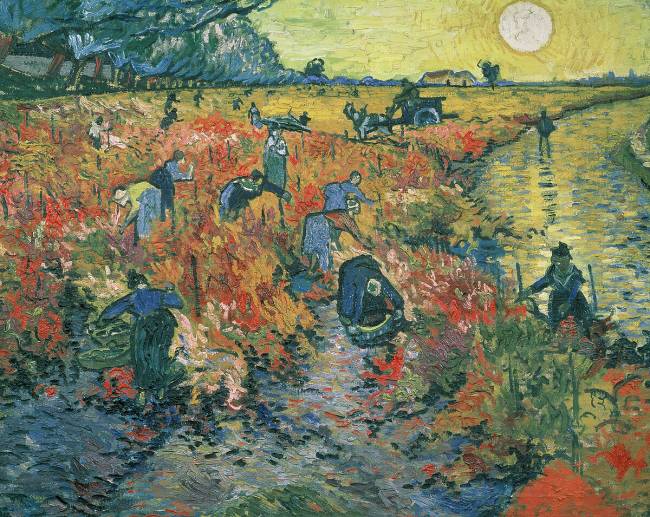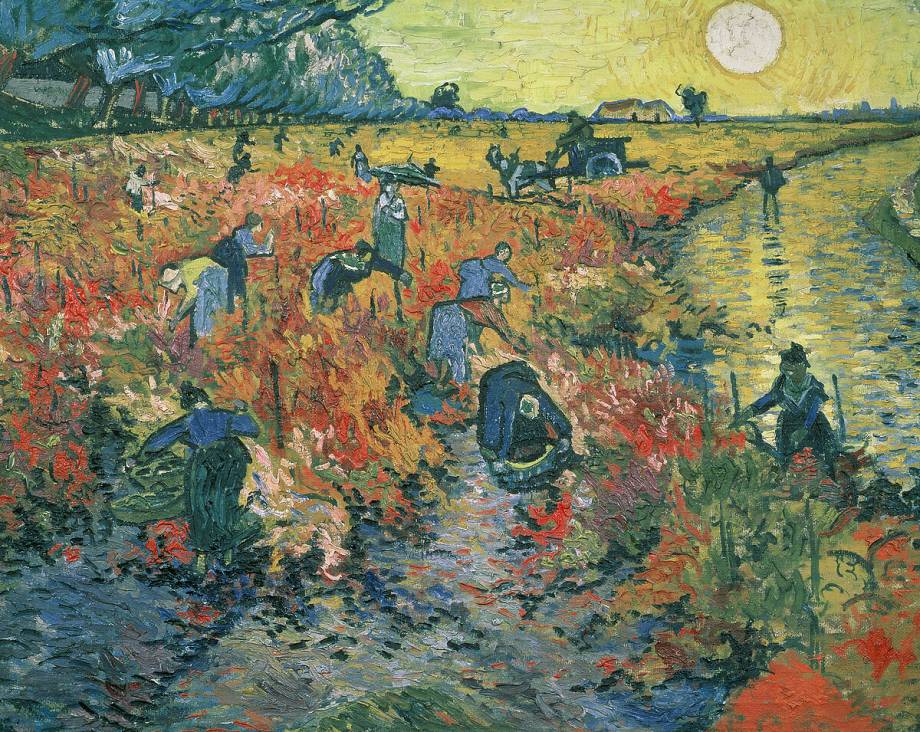Shop art print and framed art Red Vineyards at Arles by Vincent van Gogh
Customise
Your art print
Red Vineyards at Arles OF Vincent van Gogh

Red Vineyards at Arles
La Vigne rouge: a hymn to life and the work of the land
La Vigne rouge is an oil painting created by Vincent van Gogh in November 1888, during his stay in Arles, in the south of France. This was a particularly fruitful period for the artist, who, inspired by the light and vibrant colors of Provence, produced some of his most famous canvases. Van Gogh moved to Arles with the hope of founding a community of artists, a studio in the Midi where painters could live and work together. Unfortunately, this dream never materialized. Despite the failure of his project, Van Gogh found the landscapes of Arles an inexhaustible source of inspiration. He frantically painted wheat fields, cypress trees, blossoming orchards and, of course, the vineyards that stretch as far as the eye can see around the town. La Vigne rouge bears witness to this wonder at Provençal nature and the artist's fascination with the workers of the land. This painting, now preserved at the Pushkin Fine Arts Museum in Moscow and, with its dimensions of 75 cm high by 93 cm wide, is a unique work in Van Gogh's output, not least for its bold chromatic palette and subject matter.
La Vigne rouge : An autumnal landscape in vibrant colors
The painting depicts a harvest scene in a vineyard bathed in the light of the setting sun. The first thing that strikes the viewer is the explosion of color that invades the canvas. The flamboyant red of the vine leaves dominates the composition, contrasting with the yellow of the sun reflected in the sky, giving it a green hue. Other touches of color complete this chromatic symphony, creating a vibrant yet harmonious atmosphere. Van Gogh uses energetic, expressive brushstrokes, applying the paint in thick, visible strokes. This technique, characteristic of his style, gives the work an almost sculptural appearance and reinforces the impression of movement and life that emanates from it. The landscape is structured by lines of force that guide the viewer's gaze: rows of vines converge on the horizon, while the sun draws attention like a focal point.
The work of the land sublimated in La Vigne rouge
In the foreground, we can make out a group of grape-pickers busily harvesting grapes. These small silhouettes, painted in dark blue, stand out against the glowing background of the vines. Van Gogh's aim is not to depict the figures realistically, but rather to integrate them harmoniously into the landscape. They symbolize human toil, the effort and perseverance required to cultivate the land and produce its fruit. Their presence enlivens the scene, giving it a social and human dimension. Through these anonymous figures, Van Gogh pays homage to the workers of the land, whom he admires for their strength and courage.
Symbolism and interpretation in La Vigne rouge
La Vigne rouge is a work rich in symbolism. Being a ode to the work of the land and the landscapes of the South of France, the flamboyant red of the vines also evokes the devastation wrought on vineyards by phylloxera during this period. The setting sun symbolizes the end of a cycle, but also the promise of renewal. The work of the grape-pickers can be interpreted as a metaphor for human life, with its joys and sorrows, its efforts and rewards.
Some art critics also see in this painting an allegory of the communion between man and nature. Van Gogh, deeply marked by spirituality, regarded nature as a source of beauty and divine inspiration. La Vigne rouge bears witness to this deep connection between the artist and the world around him.
A seminal painting and belated recognition for Van Gogh's The Red Vine
La Vigne rouge occupies a special place in Van Gogh's career. Indeed, this is the only painting he sold during his lifetime, a few months before his death in 1890. It was acquired by Anna Boch, a Belgian artist and friend of his brother Theo, for the sum of 400 francs at the XX exhibition in Brussels. This sale, though modest, undoubtedly brought some comfort to Van Gogh, who was suffering from loneliness and lack of recognition.
The Red Vine, with its vivid colors and expressive brushstrokes, heralded the arrival of fauvism and expressionism, two major artistic movements of the twentieth century. Van Gogh, a precursor of modern art, thus paved the way for new forms of artistic expression, influencing generations of painters. Although Van Gogh was never successful during his lifetime, today La Vigne rouge is considered one of the artist's most important and emblematic works, and is among the most renowned paintings in the world.
This artwork is a painting from the modern period. It belongs to the post-impressionism style.
« Red Vineyards at Arles » is kept at Pushkin Museum, Moscow, Russia.
Find the full description of Red Vineyards at Arles by Vincent van Gogh on Wikipedia.
You may also like
- 30% !
Make good deals by browsing our Reserve : editions of our catalog which await their purchaser at a low price.























